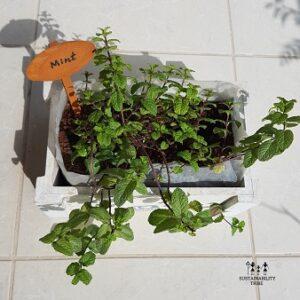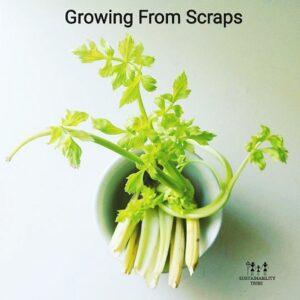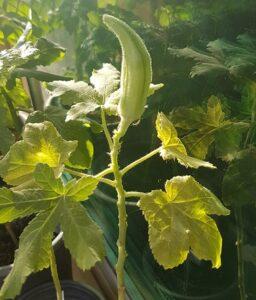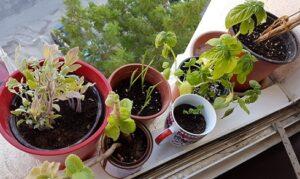It’s been a few years since I have been enjoying container gardening in the UAE. I feel gardening so relaxing that I make sure to spend at least 10 minutes every day in my balcony garden, even on my busiest day. My balcony garden is my happy place, but a lot of effort went into making it the way it is now.
My container garden is also mostly edible garden, as I feel the biggest luxury in food is freshly harvested. I have a vertical garden in my balcony mainly consist of different herbs, you can read here how I made my DIY vertical garden on a budget.
I also believe in bringing a piece of Nature & wildlife to my home through this container garden. Read here some tips for attracting birds to your garden. But most importantly my garden helps me with my zero waste lifestyle. So much waste is reduced because of this garden, I make my own fertilizers from kitchen waste and feed it to my plants. That way I also make my garden organic. Read here my top DIY Organic Fertilizers.
Now let’s see my tried and tested ways of growing food in a container garden.
REGROW FROM KITCHEN SCRAPS
Do you know so much of the food can be grown just by re-growing from the scraps? I promise once you see the photos below, you will stop throwing the vegetable scraps.
You can re-grow celery, lettuce, carrot, lemongrass, mint, garlic, onion, ginger, sweet potato list is really long. Any root vegetables like carrot, turnip, radish, sweet potato, you can just soak in water for a few days and the greens start re-growing. This way you can have access to greens and shoots of root vegetables. You can either use them in the salad of sauteing them, they taste great. You can keep these root vegetable green growing if you keep changing the water regularly.

Regrowing turnip greens
I also don’t throw spoiled vegetables because you can re-grow from spoiled vegetables as well.
This spoiled tomato turned into so many seedlings of tomato plants.

Spoiled garlic, after planting gave spring garlic. Planting garlic, ginger, and onion are easy, if they already have some green growth it’s even easier, just bury the garlic under the soil and keep green growth above the surface.

For growing mint, you can just stick the mint sticks few inches under the soil and they start regrowing.

Celery and lettuce are even easier to regrow, you just keep the base stalk in water and it starts re-growing. Just don’t forget to change the water regularly.

PLANTING FROM SEEDS
Another great way of seeing how our food grows is planting the seeds. Just make sure to buy organic non-GMO seeds for your organic garden. I have grown many herbs and vegetables from seeds like okra, tomatoes, radish, coriander, etc.
There are different technics to plant seeds otherwise the success rate is not so good when growing food from seeds. For example, avocado needs to be immersed in water in a specific way. The chili seeds need to be soaked in water before planting.

Growing radish and coriander from seeds
Many hard seeds or seeds with thicker cover need to be soaked before planting. Else you can crack the outer cover of the seeds before planting so that the seeds sprote faster.

Okra from seeds
SAVING SEEDS FOR NEXT PLANTING
One of the best ways of growing your food is from saved seeds. Here you complete a whole life cycle of food from saving seeds from fruits to planting and re-growing the same fruit. I have tried both and the results were amazing. This is the lengthiest process of all but the most joyous. You get to enjoy every step when a seed is ready to be planted or when seed sprouts or when the seedling grows and then ready to flower.

Saved pumpkin seeds
You can save seeds in two ways
- Save seeds from your homegrown fruits and veggies: When you want to save the seeds from your homegrown fruits and veggies better to let the fruit dry on the plant, that’s when you get the best seeds. Once you save your seeds, you can keep them aside and use them next season.
- Seeds from your store-bought organic fruits and veggies: In this case make sure you are saving seeds from organic fruit. Once you save the seed, you can let the seeds dry for a while and then you can plant them. I have planted seeds from store-bought chilies, lemon, tomato and it worked well.

When planting from seeds, you can either soak the seeds overnight or crush the seed cover a little to expose seeds for faster seed germination else, it takes very long in UAE for seed germination from my experience.

Edible window garden
REPOTTING STORE-BOUGHT PLANTS
This is the easiest way of growing food. You can either buy seedling or small plants and let them grow in your chosen container. Make sure to provide enough size of the container to the plants when you are re-potting. For example, you need to choose a bigger size of pot for a tiny seedling of lemon considering the size of a lemon plant. I have always bought curry leaves plants never really saw the seeds for curry leaves. I have also tried buying tomato seedling once, they gave fruits but those plants didn’t last the summer.
When repotting the plant, make sure not to disturb the roots. The healthy plant will come out quickly from the pot along with roots woven into the soil.

Lemongrass
Here Is Our Video Tutorial On How To Grow Vegetables From Scraps And Pantry Essentials,
CHOOSING PLANTERS
Choosing the right material and size of the planter is the most important thing for container gardening.
When writing about the container garden, how can I miss the opportunity to write about re-purposed planters? Read here a dedicated article about creating your own up-cycled planters out of waste. Over the years I re-purposed many different waste items like planters and some of them worked really well. Just remember whenever you are re-purposing any item as a planter; make sure to drill a drainage hole at the bottom so that excess water can run off and maintains the health of your plants. Also, make sure that you are thoroughly cleaning the container if you are re-purposing it as a planter for better health of plants. Avoid the containers which had chemical paint peeling off or has any other toxic material inside which will harm your soil. The traditional terracotta planters are porous and can dry out the soil in excess so just be careful.
Broken mugs, cups, glasses make really cute planters, especially for succulents.

Tin boxes, big and small are great planters and you can easily make a watering hole for tin boxes.
For some hanging plants, try using natural coconut shells like this one. It looks really beautiful.
Yogurt containers or any thick plastic containers are great for plants, only make sure to drill a drainage hole.

Earthen wears are really good looking planters. I have converted many take away biryani pots into pots of coriander and herbs as you need wide & shallow pots for herbs like coriander.

Biryani pot planter
I even tried this rustic looking succulent terrarium by using babies of my big aloe vera plant and some stone gift I received from a friend.

Rustic succulent terrarium
Also traditional brass and copper wares are great planters for house plants, which doesn’t need to be watered every day and you can control watering and avoid drilling drainage hole for houseplants.

Repurposing traditional Indian brass pots as planters
Finally here is one really cool re-use of a tire as a planter. This one was done as a project by my younger brother back home and I felt so proud of him!

Hope you got some ideas for your garden. I will say however small spaces you have start gardening, that’s the beauty of container gardening. I got really inspired to grow my edible garden after my visit to Iceland’s greenhouse farm and after tasting there world’s best tomato soup in a farm-to-table restaurant. I thought if Icelanders can grow tomatoes in such harsh conditions, then why not me? Read here my experience in Iceland’s farms.
If you want to get more tips about organic gardening and sustainable lifestyle join our tribe here!

